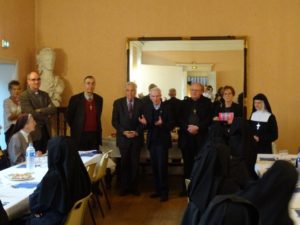
A new temporary exhibition at the Musée de la Visitation, this time dedicated to drawings and paintings created by the nuns.
Each year, the Musée de la Visitation renews the subject of its temporary exhibitions, drawing on its inexhaustible collections. With “Papers, feathers and brushes, Paintings and illuminations at the Visitation in the nineteenth and twentieth centuries”, this time it offers the discovery of an unprecedented part of the collections: the creativity of the Visitandines in the pictorial arts, and sometimes in the needle, over the past two centuries.
An exhibition whose themes are intentionally less religious and part of the collections, recent, almost contemporary: “The objective is to give the public a different approach to the collections. The exhibition will be to be discovered in particular within the framework of the Biennial of illustrators, which will take place in Moulins from September 23 to October 3, ”explain the director of the museum, Gérard Picaud and his assistant Jean Foisselon. and today by the Museum of the Visitation.
“All these fragile pieces were carefully preserved by the sisters, their context is known every time. Today we are its guardians and want to allow the public access. ”
Mercantile, playful purposes
Why have the nuns painted and drawn so much over the centuries? “The sisters practice graphic arts for commercial purposes, selling greeting cards, bookmarks, menus, communion images… which they create themselves. But also for fun purposes, such as card games and finally as spiritual and emotional gifts, ”explain Gérard Picaud and Jean Foisselon.
Paper flower characters created by the sisters. Inside, tickets for meditation. Postcards created for commercial purposes.
It is also about remembering in pictures: first, places of life. Before photography was invented, these drawings testified to the life of the nuns with those who could not enter the enclosure. Then, wars, small and big events. Thus, during the Second World War, they tell, through sketches, their exile on the roads of France during the Debacle. Or the bombardments of Rouen. They also describe more lightly the consequences of life incidents, the improvement of their daily lives with the installation of central heating … The sisters describe their daily lives, often with humor, but also of significant events such as during the Second World War, their departure from Dreux. The sisters also make wall decorations for their monastery like that of Amiens. Because some of the nuns like Marie-Bernadette Nyssen, a Liégeoise who graduated from the Academy of Fine Arts in Liège, benefit from a solid artistic training. In the midst of the neo-Gothic movement, the Visitandines illuminate beautiful books, such as this manuscript in ink on paper from 1913.
At the Visitation of Le Mans, the sisters, including Jeanne-Marguerite Gaultier, best worker in France and illuminator in 1968, copied the medieval illuminations .
Digital tablets allow you to zoom in on the details of the illuminations and to leaf through the pages of these fragile works. The public at the rendezvous of the National Center for Stage Costume, in Moulins, which offers free admission for its reopening Digital tablets make it possible to virtually leaf through works illustrated by the sisters in the style of medieval illuminations. The public will thus be able to discover the work of Sister Françoise-Marguerite Delcourt who fills in ink, pen and brush, the 96 pages of an office book enriched with 241 all different initial letters.
Partnership with the Museum of Youth Illustration Invitation to travel. German landscapes. For the first time, the Museum of Youth Illustration brought its expertise to the Museum of the Visitation: the establishment’s teams created all the frames for the paintings and drawings to be discovered in the exhibition. Some works invite you to travel: romantic watercolors of German landscapes, pictorial travel stories (Germany, Czech Republic, etc.). The nuns stick to the fashions of their time With “a certain good taste”, laughs Gérard Picaud, the sisters copy works, like the masterpieces of the Vat ican signed Raphaël. “We can see that they are also following the fashions of the day. Neo-Gothic movement, Napoleon III style … “This is not completely disinterested, because it is about sticking to the aspirations of the public.”